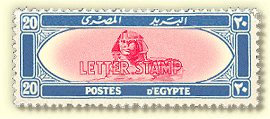

In 1932 on November 1, the postal rates were increased for overseas post with the letter rate increasing from 10millièmes (approximately 2½ pence) to 15millièmes and the postcard rate 10millièmes to 13millièmes. The peacetime British squddie in time honoured fashion moaned and groaned. In these days long before emails and even the telephone being considered a luxury mail to and from home was one of the few things to break the tedium of an Egyptian posting. There being no British military post office the mail being handled by the Egyptian post office there seemed little option but to stomach this fifty percent increase in writing to ones loved ones. To plicate the troops and make life easier for them in Egypt an agreement was reached between the War Office and the Egyptian authorities for a concessionary rate of 10millièmes. It was agreed that Britain would pay the Egyptian Government £10,000 in the first year and £6,000 in the second, to compensate for the loss of revenue caused by postal concession. The financial responsibility was taken by the Lt.-Gen. Commanding and the Air Vice-Marshal and issued a plea to make good use of the concession on fear of it being abandoned should the money paid the Egyptian authorities not be recouped So was born the Postal Concession which technically lasted until 1951. For collectors the period is normally considered to end in 1940 when free postage was introduced for troops during the second world war. During this period seven series, depends on author, of one piaster stamps (or should that be seals) with one provisional (fifth series surcharged 3 millièmes) for Christmas postcards with four issues of 3millièmes and later two series of Army Post stamps. The first series had the word 'letter seal' on them and due to the strict conditions put on their use they were not considered 'stamps' by some in the collecting fraternity and they were not included in Gibbons and other stamp catalogues. Almost immediately letters appeared in the philatelic press condemning this and despite their omission, as late as 1972, one can read about '..most interesting…most neglected..', more column inches have been given to these then many other aspects of Egyptian Philately. In 1970 John Hobbs published a book with which sold out and with frequent requests this causing him to rewrite and republish a second addition in 1984. The have become eminently collectable and are fiercely sort after not only by Egyptian collectors but by military collectors who may have no interest in Egypt beyond them. 
|
|
|